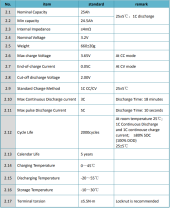meetyg
Solar Enthusiast
- Joined
- Jun 4, 2021
- Messages
- 1,093
Hi there.
I am planning a DIY solar generator, using Topband 25ah Lifepo4 cells (from BH).
I have a 12v 1500w inverter. I would like to power loads up to this rating (around 120A at 12.8v).
I have 12 25Ah cells that will be arranged in 4S3P configuration (75Ah total). Since these cells should be able to handle 2C discharge rate, this should give me the ability to run 150A loads maximum.
The reason I chose 12v is so that I would be able to use the inverter with some other ready-made 12v batteries too.
Anyways, I'm looking for a 150A DC breaker that will go between the battery and inverter (and all the other loads, like 12v sockets etc...). This will be not only for protection, but also as a main "ON" switch for the solar generator (so fuses don't help here...)
I know that the cheap Aliexpress "marine type" breakers are not recommended because they are not reliable and probably can't handle their rated amperage (especially with those little 6mm studs).
So I was looking at these Bussman DC breakers.
I came about the datasheet (attached) and was stunned!
These breakers need about 200-300% of their rated load for about 10-15 seconds in order to open/break.
This doesn’t sound good to me, because that could fry the wires easily. I want to use lowest diameter wire (highest AWG) necessary to handle 120A (maybe a bit more, but not 200%).
So, should I actually get a lower rated DC breaker (say 60-80A), so that it will break faster when 120A is exceeded? Would that be safe?
Would you recommend another type of breaker ? Like maybe this DIN rail types used for solar (if there are any at this amperage rating...) ?
Thanks in advance...
BTW: Do you really think the Bussman DC breakers are better than the Aliexpress ones? Some of them look very similar and some also use the 6mm studs...
So I'm wondering if it's really worth getting the Bussman? I mean either the Chinese are doing a great job copying these (but less reliability/quality) or maybe the Bussman are made at the same Chinese factories and are just rebranded and cost twice as much?
I am planning a DIY solar generator, using Topband 25ah Lifepo4 cells (from BH).
I have a 12v 1500w inverter. I would like to power loads up to this rating (around 120A at 12.8v).
I have 12 25Ah cells that will be arranged in 4S3P configuration (75Ah total). Since these cells should be able to handle 2C discharge rate, this should give me the ability to run 150A loads maximum.
The reason I chose 12v is so that I would be able to use the inverter with some other ready-made 12v batteries too.
Anyways, I'm looking for a 150A DC breaker that will go between the battery and inverter (and all the other loads, like 12v sockets etc...). This will be not only for protection, but also as a main "ON" switch for the solar generator (so fuses don't help here...)
I know that the cheap Aliexpress "marine type" breakers are not recommended because they are not reliable and probably can't handle their rated amperage (especially with those little 6mm studs).
So I was looking at these Bussman DC breakers.
I came about the datasheet (attached) and was stunned!
These breakers need about 200-300% of their rated load for about 10-15 seconds in order to open/break.
This doesn’t sound good to me, because that could fry the wires easily. I want to use lowest diameter wire (highest AWG) necessary to handle 120A (maybe a bit more, but not 200%).
So, should I actually get a lower rated DC breaker (say 60-80A), so that it will break faster when 120A is exceeded? Would that be safe?
Would you recommend another type of breaker ? Like maybe this DIN rail types used for solar (if there are any at this amperage rating...) ?
Thanks in advance...
BTW: Do you really think the Bussman DC breakers are better than the Aliexpress ones? Some of them look very similar and some also use the 6mm studs...
So I'm wondering if it's really worth getting the Bussman? I mean either the Chinese are doing a great job copying these (but less reliability/quality) or maybe the Bussman are made at the same Chinese factories and are just rebranded and cost twice as much?
Attachments
Last edited:




